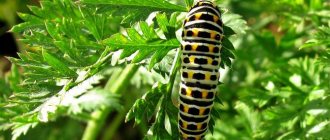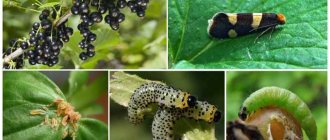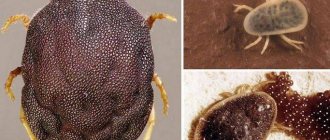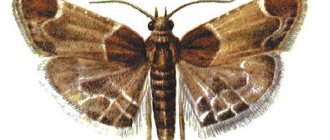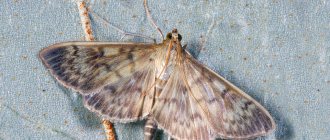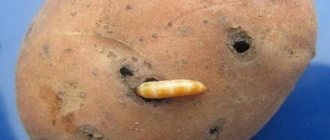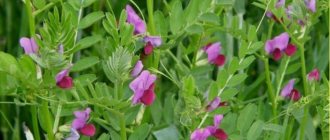It is difficult to imagine a summer cottage without the beautiful cabbage. We add it to borscht, stews, cabbage rolls, salads, and even stuff buns and pies with it. In order to get beautiful and juicy heads of cabbage, in addition to proper care, it is also necessary to protect it from pests, of which cabbage has plenty. To get rid of most of them simply and even profitably, you need to choose neighbors for the cabbage that will repel insects or use chemicals. insecticides. But first things first.
Cabbage fly
This insect appears on a summer cottage in the spring, when lilacs are just beginning to bloom. Its primary goal is to lay its larvae at the base of the cabbage stem. As soon as this happens, the larvae gradually begin to penetrate the cabbage, as a result of which the cabbage begins to grow poorly, its leaves become deformed, become purple, and then completely wither.
Methods for controlling cabbage fly
Garlic will help protect against cabbage fly invasion . Garlic should be planted near the cabbage plantation. Some gardeners plant garlic between the heads of cabbage, in the openings between the rows. Wormwood, mint and tansy, growing nearby, will also protect well from cabbage flies - their smell will prevent them from getting closer to the plant.
Also, to protect against cabbage flies, the soil around the stem is compacted. Seedlings need to be planted early. The cabbage fly can get inside the head of cabbage only because its stem is soft and pliable. If you plant seedlings earlier, then by the time of the fly invasion it will harden, and the larvae will not be able to gnaw through it.
Cabbage is a food product, so it is better not to use pesticides to control pests. If the flies do attack the plant, then the safest and easiest way to get rid of the larvae is to remove them manually and then destroy them. But this is a rather troublesome process. In fact, near each head of cabbage you need to replace the soil within a radius of 15 cm. And repeat this throughout the entire period of egg laying.
Another method of combating cabbage fly larvae is to hill up the heads of cabbage and pollinate them with a mixture of tobacco dust, ash and dried chamomile. An infusion of burdock leaves also helps. It is prepared quite simply - the burdock leaves are thoroughly crushed, thrown into a bucket about a third of the volume and filled with water. It is necessary to insist for three days, after which you spray the plants 3-4 times a day, repeat after a week.
Processing times
You can drive pests away from your garden beds or prevent their attacks with the right approach to the problem. In this case, the use of all methods is justified: biological, folk and chemical. Each method has different effectiveness.
Folk recipes and biological protection products are used when the problem first appears. In case of massive damage to seedlings or adult bushes, it is better to use chemicals. If you follow the basic rules, it is destructive to the pest and absolutely safe for the gardener.
Recommended timing of treatments with insecticidal and biological preparations:
- Early spring. Powerful insecticides are used, which are sprayed 2 weeks after planting young seedlings in open ground. The average daily temperature should be no higher than 14 degrees. Once the indicator exceeds this mark, the risk of rapid spread of cabbage and cruciferous flea beetles increases.
- Early - mid June. Treatment is carried out against the main pests of cabbage. Insecticides or broad-spectrum biological preparations are used.
- Consolidation of the result. Provided 10-14 days after the second treatment. The same remedy is used.
Attention! You can safely use chemicals until the head forms. The active substance will be completely released from the plant cells within 3 weeks, and the gardener will be able to enjoy the harvest.
Meeting deadlines is not enough. In order for the treatment to give full results - to destroy all pests and protect the cabbage from them later, you must follow these recommendations:
- choose cloudy and almost windless weather;
- study the forecast of weather forecasters and exclude rain during the day;
- add regular soap or shampoo to the solution prepared for treatment (so that the drops linger on the surface of the sheet longer);
- treat all plants (not just infected ones);
- Prepare the products used according to the instructions.
It is not recommended to exceed the doses specified by the manufacturer, because such actions may cause damage to the plant itself. It will not be possible to increase efficiency, but the gardener may well destroy the crop.
Chemicals
To treat cabbage against pests, “radical” chemistry is rarely used. This is due to the fact that it is more difficult to wash off the remaining drug from the soil and from the leaves of the head than in the case of other crops.
Most often, such treatments are carried out before the head of cabbage is formed - in the first month after planting the seedlings in open ground or a greenhouse. Then proceed with caution, choosing biological and traditional methods.
In spring, young shoots are treated with the following means:
- "Alatar";
- "Decis";
- "Aktara";
- "Spark";
- "Fury";
- "Bankol."
Attention! After the head is formed, treatment is provided by folk and mechanical methods. Insects are collected and destroyed, and then the plantings are treated with solutions that are safe for humans.
Traditional methods
Safe ingredients are used to prepare homemade insecticides. The solutions contain the following substances:
- tobacco;
- hot pepper;
- ammonia and vinegar;
- laundry and tar soap;
- roots and leaves of plants;
- mustard powder;
- table salt.
These repellents repel insects with their distinctive scent. They are completely safe for humans and plants, are not absorbed into the structure of the leaves, and do not change the taste of the vegetable. After use, the upper leaves may be slightly bitter, so they are advised to be removed. Repeated use is allowed.
Popular folk recipes that ensure the destruction of pests on cabbage:
- A solution of liquid soap and ammonia. Helps destroy aphids. Dissolve 100 ml of soap and 4 tbsp in 10 liters of water. ammonia. Mix the liquid and spray the beds.
- You can destroy the eggs of cabbage flies with a solution prepared from 250 g of salt and 10 liters of water. They water the plants separately in the holes, and then sprinkle the soil with wood ash.
- Spraying with vinegar solution. Helps in the fight against larvae and butterflies, protects against white moths and moths. Dilute 1 tbsp in 10 liters of water. vinegar essence. Mix and spray quickly, otherwise the active substance will evaporate.
- Treatment with a solution of dandelion and laundry soap. Together with the roots, 3-5 adult plants are pulled out, crushed and poured with boiling water. Leave until cooled, then add grated laundry soap (1 bar). Leave it for a day, and then spray the plants.
- Using a mixture of ash, soda and red pepper. Recipe in this video:
Attention! Prevent the rapid spread of insects. Inspect the cabbage in a timely manner and begin exterminating the pest immediately. If widespread, traditional methods may be ineffective. In this case, it is better to carry out treatments 3-4 times at intervals of 5 days.
Cabbage aphid
Cabbage aphids are the most dangerous pest of cabbage. It multiplies quickly and, accordingly, quickly destroys still unripe heads of cabbage. Aphids love the juice of cabbage leaves. They begin to deform and stop developing and growing. A characteristic sign of the presence of aphids is light yellow spots. You can see green aphid colonies with the naked eye. It is especially dangerous in hot, dry weather. During the rains, its population decreases significantly. The easiest way to reduce aphid numbers is to water your cabbage beds thoroughly.
Methods for controlling cabbage aphids
Plant a tomato plantation next to the cabbage - their smell repels aphids. Basil and dill plantations throughout the plantation will also be saved from aphids
According to the experience of summer residents, the best way to get rid of aphids is an infusion based on soap and tobacco. 400 g of tobacco dust is infused for two days in a bucket of water, after which a bar of soap (100 g) is diluted in it.
Also, a decoction of onion peels, an infusion of tomato tops, and an ash-soap solution help against aphids. One of the quick-cooking infusions to combat aphids is potato tops (1.2 kg), filled with a bucket of water and infused for 3 hours. This infusion is used to treat lesions in the evening.
Cabbage pests and their control. Universal and chemical methods of protection
Cabbage pests and their control
It should be noted that almost all pests do not like the aroma of fragrant herbs, so it is recommended to plant mint, dill, cilantro, celery, basil, parsley or rosemary near the beds or among cabbage plantings. In addition, these plants attract beneficial insects: lacewings, ichneumon beetles and ladybugs.
If you place flower beds with nasturtiums or marigolds near the plantings, this will not only decorate your plot and add charm to the garden, but will also help you get rid of harmful cabbage butterflies and aphids.
Chemicals
In addition to the folk remedies and treatment described above, you can use chemicals. Most often they are used to treat large areas, or for urgent treatment when there are already too many insects. Suitable for such purposes:
- Bankol;
- Fury;
- Iskra-M;
- Kemifos.
As a rule, the amount of product required to treat a certain area of the area is indicated on the packaging. For example, 4 ml of Bankol is diluted in five liters of water, and it is enough to treat 100 square meters.
Cruciferous flea beetles
These dangerous pests begin their activity at the moment when the soil just begins to thaw. At first they feed on weeds, after which they move on to cultivated plants. Therefore, flea beetles must be regularly weeded out, otherwise they will haunt not only cabbage, but also radishes, radishes, mustard, turnips and other plants. If flea beetles multiply, they can destroy entire seedlings of cabbage and other plants of the family in a few days.
The larvae of the cruciferous flea beetle are located in the horse system and feed on roots and root crops. After ripening, they come out and move onto the leaves, causing the plant to dry out.
Methods for controlling cruciferous flea beetles
Dusting with ash will help in the fight against massive flea infestations. It’s even better if you mix the ash with tobacco dust in a 1:2 ratio. Typically, flea beetles are especially active in dry weather. Therefore, you need to water the plantation and then immediately powder it.
Infusions of celandine, chamomile, tobacco and garlic also help against fleas. To prepare an infusion of celandine, you need from 3 to 4 kg of herbs. It is filled with a bucket of water and left for 24 hours. The garlic infusion is infused for the same amount of time. It requires 50 g of crushed cloves per bucket of water. You will need 1 kg of chamomile per 10 liters, infuse for 12 hours. Tobacco takes the longest to infuse – two days. It will require 400 g per bucket.
Main pests of cabbage
Aphids are located at the bottom of the cabbage leaves. In the spring, aphids find a new place instead of weeds and settle on newly planted cabbage seedlings. You can especially notice a significant spread of aphids in the summer months - June and August. Female moths begin to lay eggs. Therefore, during these months it is necessary to treat plants against these cabbage pests.
Thrips
Adults are able to suck all the juice from the plant. You can recognize the presence of thrips because the leaf blades begin to hurt. Then the leaves turn brown and dry out. Such processes cause their fall. They are dangerous if the area is not watered for a long period. To effectively eliminate the cabbage pest, the soil and crop should be treated immediately. For this purpose, plant treatment measures are carried out in spring and autumn. The interval between these actions is 2-3 weeks.
Cruciferous bugs
Brightly colored insects with yellow, red and white spots on a black background destroy leaves. As a result, they change color. The head of cabbage stops forming, acquiring an unsightly appearance and softness. Such processes become a consequence of the death of leaves. The larvae that emerge from the eggs are wingless and can cause irreparable harm to the entire plant. In summer they can be collected by hand, which can significantly reduce their number. Due to this, their harmfulness to the crop is also reduced.
Cabbage fly
It poses a great threat to the plant. Egg laying begins at the end of May. The larvae appear on the eighth day. Their cycle takes place in the roots and lower part of the plant stem. As a result, the organs damaged by the cabbage fly begin to rot, which leads to the withering of the plant.
White butterfly
The cabbage white butterfly has a detrimental effect on the culture. It can be recognized by the black round spots on its wings. The cabbage pest lays up to one hundred eggs on the leaves. After eight, fifteen days, caterpillars begin to appear. They are dangerous because they eat leaves down to the veins.
Owl butterfly
These cabbage butterflies are active from May to October. The female lays up to 2700 eggs. A cabbage caterpillar may emerge from these on the eighth day. Their wintering occurs in the soil at a depth of ten centimeters.
Fleas
Small bugs can damage cruciferous plants. The summer resident must immediately fight them so that they do not destroy the young seedlings. They spend the winter under plant debris.
Secretive proboscis (weevil)
The weevil begins activity in mid-May, when the soil warms up to eight degrees. At first, the secretive proboscis feeds on cruciferous weeds. Subsequently he switches to cabbage. The pest gnaws small holes in the compacted veins of the leaves. After this, the plant stops its growth and as a result dies. The presence of the pest can be detected because the leaves turn yellow.
Mole cricket
The mole cricket causes significant damage to seedlings planted in greenhouses. It is also dangerous in the garden. The pest makes underground passages and gnaws the roots of the crop. Wintering of mole crickets occurs at a soil depth of eighty to twenty centimeters. The larvae begin to appear in June-July; after the soil warms up to fifteen degrees, cabbage pest activity is observed.
Popular: Eight reasons for blackening of spathiphyllum leaves
Root nematode
This worm-like creature causes irreparable damage to cabbage grown in greenhouses. It is located in the roots of the plant. Dangerous due to the release of toxic substances. As a result, growths and swellings appear on the roots. Larvae begin to multiply inside the galls. These processes are dangerous, since disruption of the functions of the roots leads to the fact that the plant does not receive nutrition and water supply in the required volume. To eliminate the pest, it is advisable to replace the contaminated soil with healthy soil. In greenhouses, experienced gardeners recommend disinfecting the soil by applying steam.
Petiole mosquito
This insect is small in size and yellow-green in color. The pest overwinters in the soil. Eggs laid by females occur in the spring; the appearance of larvae is observed on the fourth day. Their diet consists of juices from leaf petioles. This process leads to the death of the apical bud. A decoction of wormwood allows you to destroy the pest. Spraying is carried out twice within seven days. You can protect your crop from these pests by removing all weeds after the crop has been harvested. In the autumn, the soil in the garden bed should be dug up.
Green baride
The pest is a beetle. Its dimensions are 3.5-4.5 mm. It has a dark blue color with a green tint and a metallic sheen. The beetles overwinter in the soil, the depth is five centimeters. In early spring, the pest begins to emerge to the surface. The beetle feeds on various varieties of cabbage. In this regard, the plants acquire a characteristic yellow color. After some period, growths can be noticed on them. Such processes lead to the fact that the young plant lags behind in growth.
If it is damaged significantly, then it dies. Eggs laid by females occur in late April early May. The appearance of larvae is observed on the tenth day. They settle in the stems of the plant, feeding on them. This leads to a significant reduction in yield. If the goal is to prevent the influence of this pest, you need to perform deep plowing and pay attention to the destruction of weeds of the cabbage family. Care should be taken to ensure that no vegetation remains in the beds.
Cabbage weevil
This beetle is found in the zone from Karelia and the Baltic states to Transcaucasia. It harms not only cabbage, but also turnips, radishes and other plants. Its larvae are especially harmful, as they devour cabbage leaves and destroy the plant.
Methods for controlling cabbage weevil
Affected leaves and sections of cabbage are collected and destroyed, after which the opening between the rows is carefully dug.
To combat the beetle, chemicals are used - trichlorometaphos (10%) and karbofos (10%). These preparations should be sprayed on cabbage heads. Dilute according to instructions.
Chemicals for pest control
Often, all the efforts of gardeners to combat pests do not give the desired results. The weather also plays a role in this: if there are dry, hot days, harmful insects develop faster. At the same time, they also eat plants more intensively. In these cases, we have to look for more effective methods.
Chemical agents give good results in pest control. Cabbage pest control products contain the following arsenal:
- The drug "Actellik". It is used in a proportion of 20 ml per 10 liters of water to spray 10 square meters. one liter of solution is required.
- “Bankol” is a biological product obtained from marine annelids and is used in a similar way to the first remedy.
- In large production areas, cabbage processing is effectively carried out using the preparations “Decis”, BI-58, “Karate”.
- Such strong chemicals as “Antio”, “Karbofos”, “Decis Extra”, “Rovikurt” are recommended only when plants are critically infested with pests.
- Also, in case of a sufficiently strong attack of harmful insects, microbiological preparations “Bitoxibacillin”, “Lepidocid”, “Dipel” are used.
- To combat the proliferation of harmful insects, chemical preparations such as Bazudin, Zeta, Biorin, Karbofos, Kinmiks, Fosbecid, Diazinon, Fitoverm, Intavir are used.
scoop
The cabbage cutworm causes enormous damage to the cabbage crop. More precisely, not she, but her offspring. Caterpillars eat cabbage heads over the entire surface, leaving round holes. They make passages and leave their excrement in them.
Methods to combat armyworms in the garden
Sage and savory have an unfavorable effect on the cutworm, so planting these plants near cabbage will repel it. Decoctions and infusions of celandine, dandelion roots and leaves, burdock leaves, and wormwood herb will help repel and destroy cutworm caterpillars. The infusion of hot pepper is especially good. To prepare it you will need 100 g of fresh or 50 g of dry peppercorns. They are poured with a liter of water and boiled for an hour, after which the broth is infused for two days, filtered and stored in a closed container. Then you need to take 0.5 liters of the resulting infusion, dilute it with a bucket of water, and add 40 g of soap. The remedy for caterpillars is ready! Now you need to spray the plant itself and the soil around it with this preparation several times. This infusion is easy to prepare and can destroy not only the cutworm, but also many other cabbage pests. Cutworm butterflies are attracted to light. You can take advantage of this by building a fire at night and catching all the moths by hand.
Cabbage leaf beetle
A pest such as the cabbage leaf beetle is widespread throughout almost the entire area. It is a small five-millimeter beetle, shiny, ovoid in shape.
The insect damages leaves by eating large holes in them. Insects overwinter in the soil, hidden by warm plant debris, and crawl out in the spring. In the eaten pulp of leaves, female leaf beetles lay eggs, from which larvae emerge after a couple of weeks. They also feed on the skin of the leaf. After about 3 weeks, the larvae descend to the ground and pupate, and after 10 days, beetles are born from the pupa.
Slugs and snails
Slugs and snails love places with high humidity. Their habitat includes both underground and aboveground parts. Cabbage roots are at risk.
Methods for controlling slugs and snails in the garden
The borage plant is excellent at repelling slugs. To do this, it needs to be planted throughout the cabbage plantation. The following mixture helps against slugs - 0.5 liters of ash, 2 tbsp. Mix spoons of salt, dry mustard, pepper thoroughly and pollinate the soil between the cabbage rows. 1-2 teaspoons of mixture per meter is enough. After pollination, the soil is loosened to a depth of 3-5 cm. For better effect, this procedure can be carried out in dry weather - the most unfavorable period for slugs. On the same day, it is necessary to pollinate the plant itself with the same mixture. The procedure is repeated at intervals of 5-6 days. If you bury nettles in the corners of a cabbage bed, it can protect the heads of cabbage from the invasion of slugs and snails. We described in detail how to deal with snails in the garden here .
Root damage
Sometimes it happens that there are no traces of the pest on the leaves, but the plant withers and looks depressed. This is a sign that the cabbage roots are damaged. The roots can be damaged by the larvae of the cockchafer and mole cricket.
These pests do not tolerate nitrogen well. Methods to combat them are based on this: you can sow white clover around the flower bed. Legumes are able to absorb nitrogen from the air and accumulate it in the soil. Another source of nitrogen is feeding cabbage with infusions of mullein, bird droppings or green grass. This will drive away soil pests and feed the plants.
Turnip and cabbage whites
Belyanka, or in common parlance - cabbage grass, appears on the plots in June. At the same time, she lays her offspring on the cabbage leaves, which eat the pulp, as a result of which only veins remain on the leaves.
Methods of combating turnip and cabbage whites
Wormwood, mint and tansy, planted near a cabbage plantation, effectively repel white grass.
The appearance of cabbage marks the beginning of the fight against the pest. It is necessary to inspect cabbage once a week for the presence of larvae and, if found, destroy them. Of course, it will not be possible to identify all the larvae, but this way you can prevent the mass spread of butterflies, and also do without the use of special drugs for some time.
An effective remedy against whites is a solution of wood ash in a ratio of 2 cups per 10 liters, after which you need to dissolve a tablespoon of liquid or just laundry soap in it. The solution is sprayed onto the plants.
Watering the cabbage with the following solution gives a good result. In a bucket you need to dilute 2 tbsp. spoons of mustard, the same amount of salt, a teaspoon of ground pepper (black or red).
Summer residents sometimes hang eggshells all over their cabbage plantations. It is said to repel cabbage butterflies.
Cruciferous bug pest
Common pests of cabbage are cruciferous bugs. An adult of this insect has a body ranging from 5 to 10 mm in length. Bedbugs overwinter in weed thickets, piles of fallen leaves, and in vegetable gardens. In mid-spring, they begin to eat cabbage leaf weeds and early cabbage crops. And with the beginning of summer, female bedbugs lay eggs, from which, after a couple of weeks, larvae are born, which grow in a month.
Plants are harmed by both larvae and adult insects. They pierce the skin of the crop and suck the juice from the leaves. Droplets of bug saliva remain in the leaf wound, containing enzymes that kill leaf cells. The leaves curl and die. Adult plants begin to grow poorly, so to get a good harvest, cabbage pests must be controlled.
Rapeseed sawfly
This false caterpillar feeds on the juice and pulp of cabbage leaves, leaving only large veins. Females lay eggs in the cut of the leaves, so all damaged leaves must be torn off and destroyed.
Methods for combating rice sawfly
Tomato tops perfectly destroy rapeseed sawfly and protect cabbage heads. 1 kg of tops is poured with a bucket of water and left for 5 hours, then boiled for about 3 hours, filtered and diluted with another bucket of water.
General recommendations for protecting cabbage beds from pests
Next to cabbage you can plant crops such as carrots, celery, caraway seeds, parsnips and others. These plants attract insects that feed on cabbage pests. Calendula, marigolds, and nasturtium also help against aphids, flies and butterflies.
To avoid the spread of insects, cabbage must be properly cared for - pull out weeds, loosen the soil, feed and promptly plant seedlings in the ground. Cabbage also loves moisture, but not its excess. Care for cabbage correctly, and it will delight you with its tasty, large and juicy heads.
Cabbage pests photo. Cabbage moth butterflies and larvae
Cabbage moth larvae
The inconspicuous-looking white cabbage moth, or gray cabbage moth, is one of the most dangerous pests for cabbage plantings. It lays millions of eggs, from which yellow-black caterpillars eventually emerge, capable of completely destroying the future harvest. Larvae often end up even in cabbage heads.
There are quite a lot of answers to the question of how to spray cabbage against pests. Experienced gardeners recommend using several traditional methods simultaneously. At the same time, you should choose them depending on the type of parasite that has settled in your beds.
- To spray plants in dry weather, use an infusion of liquid soap (2 cups) with ash (one tablespoon) per 10 liters of water.
- Treating the garden with a tincture of onion peels, which will repel insects with its strong smell, is considered useful for fertilizing the soil and plants. To prepare a miracle cure, you need to take 0.5 kg of husk, pour 4 liters of hot water and leave for a couple of days, before using, add a spoonful of tar shampoo. Spray cabbage every 3-4 days.
- Cabbage is also protected from pests using regular baking soda, which is sprinkled on the seedlings (it is important not to overdo it; if there is no effect, you can repeat it).
- Cabbage pests are afraid of wasps, as they eat their eggs and larvae. This can be used for the benefit of the future harvest. Sugar syrup or old, diluted jam - this is what to pour on cabbage against caterpillars, inexpensively and effectively. Wasps instantly flock to the smell of sweets and at the same time feast on insects.

